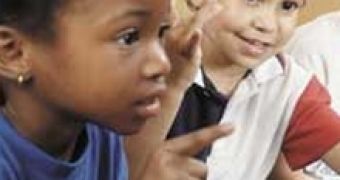Autism is a complex disability which appears during the first 3 years of life. Autism comes from a neurological disorder which hits the brain, impairing social interaction and communication skills. Thus, children and adults who suffer from autism have difficulties in verbal and non-verbal communication, social interactions, and leisure or play activities. Autism affects 1 in 166 births and grows at a rate of 10 to 17% per year, 1.5 million Americans having so far a form of autism. Considering this increase, it is estimated that, within a decade, 4 million Americans will be affected.
Children and adults with autism can display any combination of behaviors characteristic to the illness in any degree of severity. Two children, both with the same diagnosis, can act completely different from one another and have varying capabilities. Two common characteristics among infants include arching their back away from their caregiver to avoid physical contact and failing to anticipate being picked up. Some people, with the disease in a mild form, have difficulties in initiating and maintaining a conversation. Many experience challenges with social interactions and an aggressive behavior.
Some children with autism are considered passive, who are quiet most of the time making little, if any, demands on his/her parents, and some are extremely agitated, crying a great deal, sometimes non-stop, during his/her waking hours. They may insist on the same thing, oppose to change, have difficulty in expressing needs, using gestures or pointing instead of words, repeat certain words or phrases. Autism patients may laugh or cry for no apparent reason, prefer being alone, may have difficulty in mixing with others, obsessive attachment to objects, make little or no eye contact, be unresponsive to normal teaching methods or acts as if deaf, although hearing tests are in normal range.
Senses, which help a person to understand what he/she experiences, are affected by autism, lessening or aggravating certain ones. Some children with autism are sensitive to sound, finding normal noises as painful. Many people believe that children with autism cannot show affection. Parents of such children need time and patience to accept and give love in the child's terms, the latter showing affection in different ways.
Some studies indicate that autism may have a genetic influence behind it. It is more possible that 2 monozygotic twins, or identical twins, will have autism, as opposed to 2 dizygotic twins or fraternal twins. Many researches have been focused on finding the autism gene, while other linked the disease to a weakened or compromised immune system. Other studies have shown that depression and dyslexia are common in a family when autism is present.
Some doctors worry that toxins and pollution in the environment can also lead to autism. In the small town of Leomenster, Massachusetts, where a factory manufacturing sunglasses was once located, many people suffer from this disease. Most of the cases have been found in houses in the way of the smoke which came from the factory.
In individuals with autism, 2 types of abnormalities have been discovered in the brain: dysfunctions in the neural structure of the brain and abnormal biochemistry of the brain. Future studies will try to examine the relationship between the two abnormalities and the role they play in causing autism. Whatever the causes may be, it is clear that children suffering from autism are born with this illness or have an increased potential of developing it.
Families have tried over the years all kinds of treatments to increase appropriate behavior, reducing autistic symptoms. Some drugs are used to improve the person's state, but no primary medicine has been shown effective for treating autism. So far, the use of vitamin B6 with magnesium supplements has received the most support. The combination increased the general well-being, awareness, and attention in approximately 45% of autistic children.
Scientists discovered that some people with autism have excessive amounts of a type of yeast called candida albicans in their intestinal tract. The cells which regulate this substance could have been destroyed by antibiotics given to children to fight a middle ear infection. After the antibiotics, the amount of yeast will then grow rapidly, releasing toxins into the blood, which may influence the normal functioning of the brain.
Diet has also been shown to play an important part in the life of children suffering from autism. High levels of peptide in the urine of autistic individuals have been discovered, due to the body's incapacity to break down proteins like gluten (in wheat, oats) or casein (in human and cow's milk). Parents who removed these foods from the children's diets noticed considerable improve in their condition.
50 years after Dr. Leo Kanner, a psychiatrist at Johns Hopkins University, wrote the first paper applying the term autism to a group of children with severe social, communication, and behavioral problems, we can finally begin to understand and treat these children. Though this complex condition cannot be cured, parents and doctors need to work together in order to treat and introduce into the society these challenged children.

 14 DAY TRIAL //
14 DAY TRIAL //